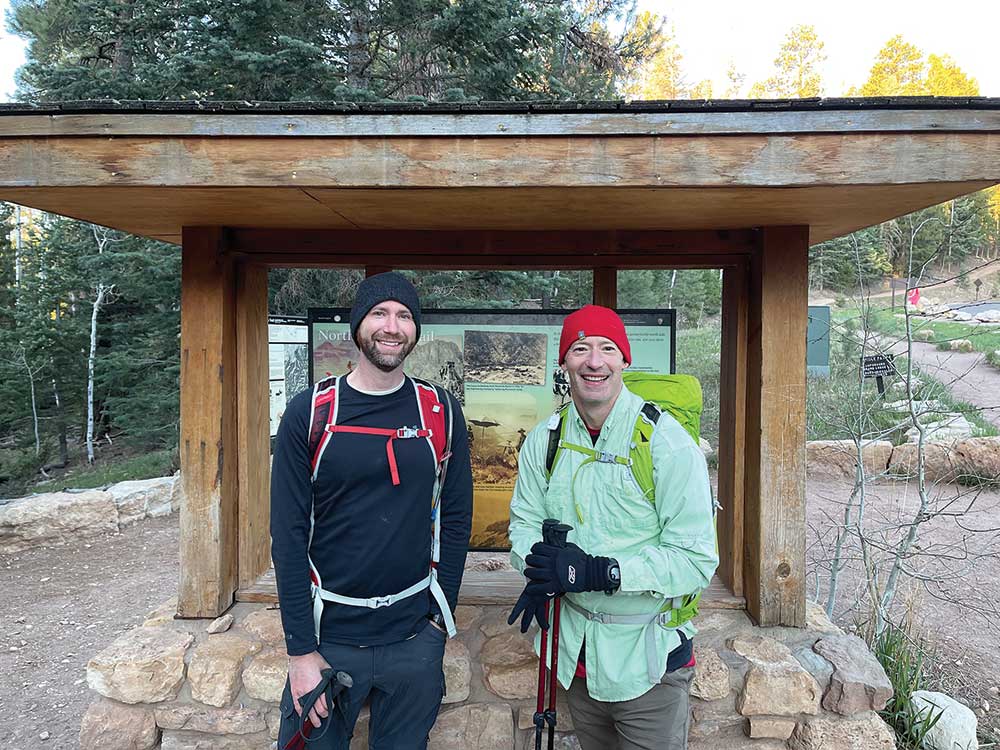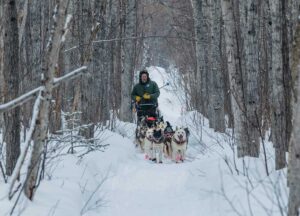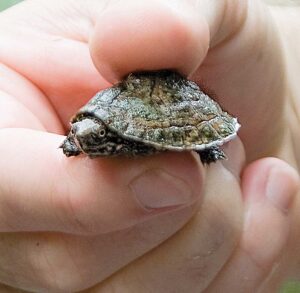
Pair of Pell City engineers ‘engineer’ a Grand Canyon adventure
Story by Scottie Vickery
Submitted photos
John Jones remembers reading a quote years ago that’s been on his mind quite a bit recently. The gist is that if you pick something to tackle, and it doesn’t seem impossible at the beginning, you didn’t choose something hard enough.
Jones and Dennis Vandegrift, his friend and co-worker, don’t have to worry that they set their sights on something too easy. Their idea to hike the Grand Canyon rim-to-rim-to-rim in two days was a daunting one. Five months after achieving their goal, they’re still amazed at what they accomplished.
“A little over a year ago, (we) hatched an insane idea” Jones said in a Facebook post after returning home. “We thought we should try to hike from one rim of the Grand Canyon to the other and back over two days. 110,000-ish steps, 45 miles, 20,000 feet of elevation change, and I’m not sure how many training hikes and runs later, we did it. I’m honestly more than a little surprised we pulled it off.”
Not many people do. According to the National Park Foundation, a partner of the National Park Service, fewer than 1% of the Grand Canyon’s 5 million annual visitors even venture below the rim – and many of those just hike a few miles. The ones who hike rim to rim, typically over two days, are even fewer.
Then there’s Jones and Vandegrift, who did it twice. They hiked from the North Rim of the canyon to the South Rim in 12 hours, spent the night in a hotel, and hiked back from the South Rim to the North the next day.
“It was cool, but it was a little bit nuts,” Jones said. “The more it’s in the rearview mirror, the cooler it becomes.”
The planning stages
Both Jones and Vandegrift, structural engineers with Barnett Jones Wilson in Pell City, are avid outdoorsmen. Jones, 49, is a hiking and backpacking enthusiast while Vandegrift, 41, competes in triathlons and owns Off-Road Multisport, which hosts swim/bike/run/paddle off-road race events in Alabama and Northwest Florida.
The two are always up for a challenge, and Jones proposed this one. “I mentioned it to Dennis, and it took him five seconds to say, ‘We’re doing it,’” Jones recalled.
They had to work quickly since lodging sells out a year in advance. “We hatched this plan 54 weeks before we could do the trip, so we had to make a lot of quick decisions,” Jones said. “The first day we were eligible, we booked everything.”
Their goal was to hike rim-to-rim-to-rim, but they decided to arrange for a shuttle at the South Rim in case they got there and weren’t up to hiking back. “We thought it would be a cheap insurance plan,” Jones said. Because of COVID, though, there were fewer shuttle options than normal, and all were booked. “At that point, it was all or nothing,” he said.
They began training in earnest. “I felt like I was the weak link,” Jones said. “He could have shown up ready to do it, but I definitely had a lot of conditioning to do. I was more worried about my general fitness level, and Dennis was more concerned about his feet and knees.”
The Grand Canyon hike is different from most, Vandegrift said, and they kept that in mind while training. “It’s like a reverse mountain climb,” he said. “You’re doing the descent first and then the ascent at the end when you’re tired. Normally, you get to the top, and you have gravity to bring you home.”
Another issue is temperature changes. The North Rim doesn’t open until May 15 because it’s got a much higher elevation than the South Rim, and ice and snow can be issues. “The first morning, it was 25 degrees when we left,” Vandegrift said. “By midday at the bottom, it was 90.”
Training included lots of hikes at Mt. Cheaha, and Jones had a previously scheduled hike in Wyoming. He also headed to Clingmans Dome in the Smoky Mountains after planning a hike that mimicked the Grand Canyon one as closely as possible.
“It was about 25 miles with 9-10,000 feet of elevation changes,” Jones said, adding that he started high, hiked down first and then back up. “I figured if I couldn’t do it in the Smoky Mountains when it’s 50 or 60 degrees, I couldn’t do it in the Grand Canyon when it’s in the 90s.”
Hiking the canyon
The two headed to Arizona on May 22. They camped out the night before the first day of hiking, which Jones said was their only big mistake. “We should have stayed in a hotel,” he said. “We had to break camp that morning, which took a long time, and it was cold. We were shooting to leave at 5 a.m. but it was more like 6:30.”
Each carried only the bare necessities in his pack – a toothbrush, water, change of clothes and two days’ worth of trail food, Vandegrift said. They planned to eat dinner at the hotel once they made it to the South Rim that evening, and there were water stations every three to five miles, so they never had to carry more than two quarts of water. “The packs probably weighed 18 or 20 pounds starting out, which is light for a pack,” he said.
One of the first things they noticed before setting out was all the warning signs around the Grand Canyon. “Hiking to the bottom of the Grand Canyon is optional. Hiking out is mandatory,” one read. Even still, they were determined. “I think where most people get in trouble is when they don’t respect it and understand it going into it,” Vandegrift said. “We knew it was going to be hard as hell.”
By the time they reached the bottom of the canyon on the first day, they were feeling it. They stopped for lunch and a cold glass of lemonade at Phantom Ranch, which offers the only lodging below the rim of the canyon and is accessible only by foot, mule or by rafting the Colorado River. Although many hikers stay the night, Jones and Vandegrift still had the ascent to the South Rim ahead of them.
“At one point we still had to hike nine more miles and gain 4,400 vertical feet to get to the hotel room,” Jones said, adding that the distance included a three- to four-mile section they later learned is nicknamed Heart Attack Hill. “We both had heart monitors on our watches, and they were beating pretty fast,” he said with a laugh.
By the end of the first day, all they could think about was food and a hot shower. “Our hotel room had a claw-foot tub that you had to step into. When we walked in and saw it, we were like, ‘Are you kidding me?’” After a hot dinner and a load of ibuprofen, they went to sleep only to be awakened by horrible leg cramps.
Getting up to catch the 5 a.m. shuttle to the South Kaibab trailhead was painful, and they started the hike in the dark with headlamps. A few miles in, they were rewarded with an incredible sunrise. “There are 360-degree views, and the sun just illuminates everything,” Vandegrift said. “It was incredible.”
Although they had seen some beautiful scenery and a full-size ram that jumped out of nearby brush the day before, they both agreed that the South Kaibab Trail, which is very steep, was their favorite. “In the really steep sections, you could look down and see as many as 10 switchbacks,” or zigzags of the trail, Jones said.
“You could see someone down below, and they seemed so close, like you could throw a rock to them, but they were probably an hour ahead on the trail,” Vandegrift added.
The views were spectacular. “If we had hiked that section and spent twice as much time there, it still wouldn’t have been enough; it was just so scenic,” Jones said. Vandegrift agreed. “You can take a million pictures and it doesn’t begin to capture it.”
Mission accomplished
By the time they made it back to the North Rim about 5 p.m., they were hungry, tired and had a 3-hour drive to their hotel ahead of them. They got a bison burger at a drive-through, turned in early, headed home the next day, and were in the office the day after that. “I don’t think we had that ‘we did it’ feeling until that first day back in the office,” Vandegrift said.
Although they were disappointed that they never saw a herd of bison, which are often spotted at the North Rim, Jones and Vandegrift said they loved the experience and the challenge. “The first three miles and the last three miles each day were the hardest,” Jones said.
Although they pushed themselves, they never considered quitting. “At the end of the first day when we still had a few miles left to go, I was feeling apprehensive about the second day,” Vandegrift said. “But you settle in, get down to business and start walking. It was two really long days of hiking, and there are times we were hurting, but it was never, ‘We’re about to die.’ We never thought that we weren’t going to finish.”
Jones said he was proud of their achievement and the determination that carried them through to the end. “My daughter runs cross country, and she would go to Cheaha with me and Dennis for some of our 13- to 14-mile training hikes,” he said. “She’d be running up the hills, and I was struggling to get up them.
“She saw me struggling in November with something that shouldn’t be that hard if you’re going to do what I signed up to do,” he said. “Then she saw what I did and saw what you can accomplish if you put your mind to it. That’s a pretty good feeling.”

















